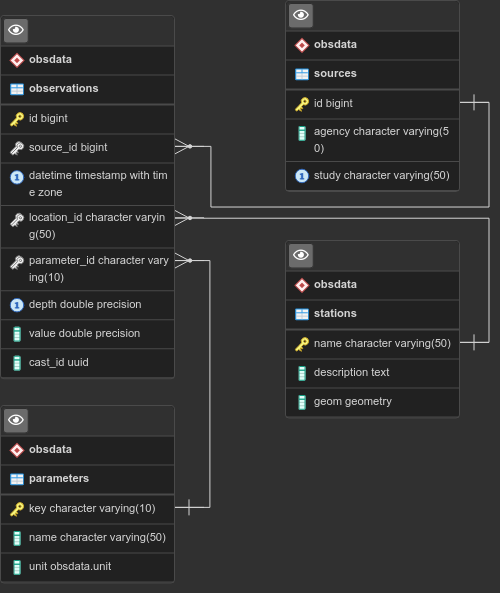Puget Sound Observation Database
A collection of Python scripts and notebooks for the creating and loading of a database of observation data for Puget Sound water quality. The notebooks process data files that are publicly available from their respective agencies, either online or by public disclosure request. Most of the data is not hosted in this repository, but the notebooks are intended to be able to extract and load the data from the format each agency typically provides, with minimal manual processing.
- All parameters are transformed to use common measurement units, which are
self-described in a
parameterstable. - All timestamps are in UTC to avoid any daylight savings confusion.
- Data collected as part of a CTD cast is assigned a common UUID so a depth profile can be interpolated easily, as opposed to discrete bottle measurements.
- The tables use natural keys whenever reasonable.
- The schema contains foreign key and unique constraints to avoid data duplication or breaking the table relationships.
- Measurement locations are tracked in a PostGIS-enabled
stationstable with coordinates in UTM zone 10. NANOOS cruises often report slightly different coordinates for common station names, and these location differences are preserved by creating unique entries in the table for them. - The source of each observation is tracked through a relationship to a
sourcestable, so every record can be traced back to its original provider.
Database Setup
The Postgres database schema is in db.sql. It was created with pg_dump --file db.sql --host <hostname> --port <port> --username <username> --verbose --format=p -C --schema-only "puget_sound_obsdata".
To get started, create the database on an instance of Postgres with PostGIS installed by running
psql --set ON_ERROR_STOP=on postgres < db.sql
The database will automatically be given the name puget_sound_obsdata, but
this can be customized by editing the SQL script before running.
Database connections are handled through a Python module named db.py. This
simple module assembles a SQLAlchemy connection string by reading connection
options from a config file named db.ini. You must create this file. It
should be in the standard Python configparser format and contain the following,
as an example:
[db]
hostname = db_host
post = db_port
username = db_user
password = db_password
dbname = puget_sound_obsdata
All of the above parameters should be set according to your local configuration.
The ETL Notebooks
Certain notebooks need to be run before others to populate the database. The order listed here should work, although not all of them depend on each other so tightly; for instance, you can probably run the PRISM notebook before or after the King County ones.
load_initial_data.ipynb: Populates theparameterstable. This must be run first.load_ecology_ctd.ipynb: Extracts, transforms, and loads Washington Department of Ecology CTD cast data from the Marine Water study, downloadable from EIM.load_ecology_bottle.ipynb: Extracts, transforms, and loads Washington Department of Ecology lab-analyzed bottle data from the Marine Water study, available by public request from the agency. This notebook depends on the CTD notebook having been run first to create the source, and provide CTD data which has more precise time specification than the bottle spreadsheets tend to have.load_cruises.ipynb: Extracts, transforms, and loads Salish cruise data available from NANOOS. All of the .zip files available for download can be imported, but take note that not all cruise files contain the lab data. I was able to request the missing lab data in a NetCDF format directly from NANOOS staff, and this notebook will load those NetCDF files as well when it detects that lab data is otherwise missing for a particular cruise.load_kingcounty.ipynb: Extracts, transforms, and loads various King County Marine Monitoring data. Some of this is directly downloadable from the program website, while the lab data is available by request from the marine water quality group.load_orca_buoys.ipynb: Extracts, transforms, and loads ORCA buoy data that is downloaded as Matlab files from Northwest Environmental Moorings.
Data Quality Control
The notebooks perform some automatic QA filtering by removing any data that is suspect or flagged as inaccurate. It should be noted, however, that this is not intended to be a complete quality assurance process for the dataset; manual review may be required for your application if you intend to do more than just basic research with the data.
